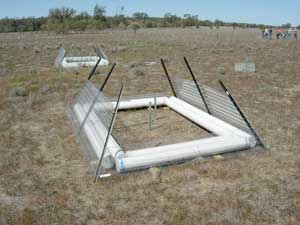Systematics and Evolution (HA) + CSIRO Program S
Invasive Ecology

Experiments to modify micro-environments in the field
|
Team Leader: Bob Godfree
Invasive species are a major problem for conservation of native vegetation both in Australia and globally. Invaders frequently dominate native plant communities, changing their structure, floristic composition and conservation value. This project focuses on dynamics of invasions within native plant communities.
Current research is aimed at understanding ecological function, structure and small-scale dynamics of grassland communities in southeastern Australia. In particular, our research is focused on understanding the importance of community diversity on invasibility. Our study area encompassess structurally similar but floristically diverse grassland communities from alpine areas (e.g. Mt Carruthers, Koscziusko NP) to the western plains of New South Wales (e.g. West Wyalong area). Extensive surveys have been undertaken at a range of spatial scales, ranging from 0.01 m2 to geographic (300+ km), with data collated on species composition, abundance, cover, functional classes and trait characteristics, for over 500+ taxa, both native and exotic. Preliminary evidence suggests that diversity of native species tends to be positively related to invasibility at all spatial scales and that a few dominant grasses generally exclude all other subordinate species in SE Australian grassland assemblages. These results suggest that managing native grasslands for higher diversity is unlikely to be an effective strategy to minimize invasion by exotic species.
We are also focusing in more detail on small-scale community interactions within the Austrostipa aristiglumis grasslands of the West Wyalong area. These communities are of particular interest because they have been heavily invaded by functional groups (e.g., annual grasses and annual legumes) that are rare or absent in the native flora. In an ongoing project we have been examining the effects of exotic species on the native grassland flora through a series of manipulation experiments involving hand-removal, grazing and other treatments, along with other research into soil nutrient levels, water availability and other related factors. A greater understanding of the factors leading to invasion of these endangered communities will lead to a better understanding of the mechanisms of invasion in regions with erratic climates, and to better management of native biodiversity. A climate change component has also recently been initiated, researching the potential effects of predicted climate change on the composition of these communities.
.
|
![An Australian Government Initiative [logo]](/images/austgovt_canbr_90px.gif)

![An Australian Government Initiative [logo]](/images/austgovt_canbr_90px.gif)



